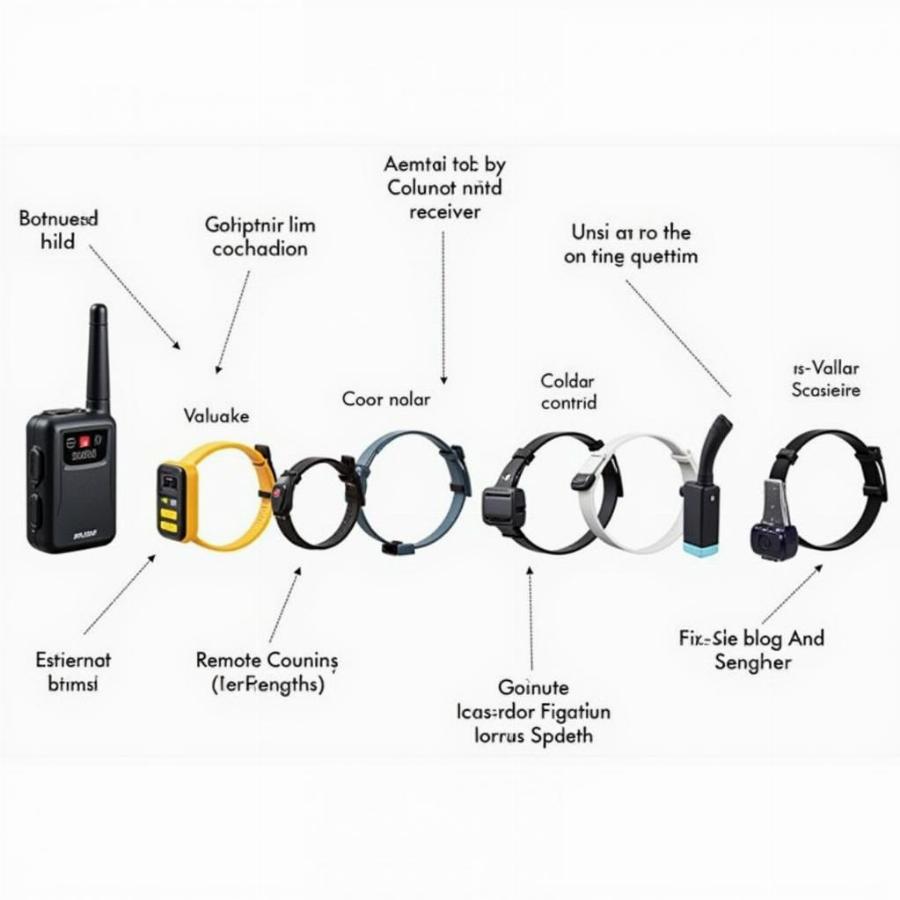Finding the best e collar for dogs can be overwhelming with so many options available. This guide provides in-depth information on choosing, using, and understanding electronic collars for training and behavior modification in canines. We’ll cover various types, features, and important considerations to ensure you make an informed decision that prioritizes your dog’s well-being and safety.
Understanding E-Collars for Dogs
E-collars, often referred to as shock collars, training collars, or remote collars, use electronic stimulation to communicate with dogs. They aren’t meant for punishment, but rather as a tool to reinforce commands and discourage unwanted behaviors. Choosing the right collar is crucial for effective training and a positive experience for both you and your furry friend. It’s important to understand that not all e-collars are created equal. Some deliver static stimulation, others vibration, and some even offer tone-only options.
 Choosing the right e-collar for your dog
Choosing the right e-collar for your dog
Types of E-Collars
Understanding the different types of e-collars is crucial for making the right choice.
Static Stimulation Collars
These collars deliver a brief, mild static correction. The intensity is adjustable, allowing you to find the lowest effective level for your dog.
Vibration Collars
These collars use vibration to get your dog’s attention. This can be a less intrusive option for sensitive dogs or for basic training.
Tone-Only Collars
These collars emit a tone or beep, useful for reinforcing commands already learned. They are often used in conjunction with other training methods.
Choosing the Right E-Collar: Key Considerations
Several factors play a role in selecting the best e collar for dogs.
- Dog’s Size and Temperament: A small, sensitive dog will have different needs than a large, energetic breed. Consider your dog’s individual personality and sensitivity when choosing the type and intensity of stimulation.
- Training Goals: Are you looking to address specific behavioral issues or reinforce basic obedience? Your training goals will influence the features you need in an e-collar.
- Range: How much distance do you need between you and your dog for the collar to function effectively? This is especially important for off-leash training.
- Features: Look for features like waterproof designs, rechargeable batteries, and multiple levels of stimulation.
How to Use an E-Collar Safely and Effectively
E-collars should always be used responsibly and humanely.
- Start with the Lowest Setting: Begin with the lowest level of stimulation and gradually increase only if necessary.
- Pair with Positive Reinforcement: Use the e-collar in conjunction with positive reinforcement techniques like praise and treats.
- Consistency is Key: Use the same commands and cues consistently to avoid confusion.
- Consult with a Professional: If you’re unsure how to use an e-collar properly, consider consulting with a certified dog trainer.
Best E-Collar for Big Dogs: Specialized Considerations
Larger dogs often require e-collars with more range and potentially higher levels of stimulation. best shock collar for big dogs addresses these specific needs. Similarly, if you are looking for calming solutions, exploring the best calming collar for dogs might provide helpful insights. Training collars play a crucial role in canine development, and our article on the best training collar for dogs provides comprehensive guidance. For general collar options for larger breeds, best collar for large dogs offers various choices.
FAQ: Your E-Collar Questions Answered
- Are e-collars cruel? When used correctly and responsibly, e-collars are not cruel. They are a training tool, not a punishment.
- Can I use an e-collar on a puppy? It’s generally recommended to avoid using e-collars on puppies younger than six months old.
- How do I find the right stimulation level for my dog? Start with the lowest setting and gradually increase until you find the lowest level that gets your dog’s attention.
- What if my dog doesn’t respond to the e-collar? Consult with a certified dog trainer for personalized guidance.
- Are there any alternatives to e-collars? Yes, positive reinforcement training methods, like clicker training, are effective alternatives.
Conclusion
Choosing the best e collar for dogs involves careful consideration of your dog’s individual needs, your training goals, and responsible usage. By understanding the different types of collars, their features, and safe training practices, you can make an informed decision that supports a positive training experience for both you and your canine companion. Remember to prioritize your dog’s well-being and seek professional guidance when needed.
Beaut Dogs is your go-to resource for all things canine. We provide expert advice, helpful tips, and in-depth guides to help you navigate the world of dog ownership. For further assistance and personalized recommendations, contact us via Email: [email protected]. Beaut Dogs is committed to providing you with the information you need to care for your furry friend.